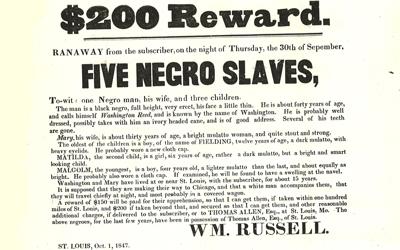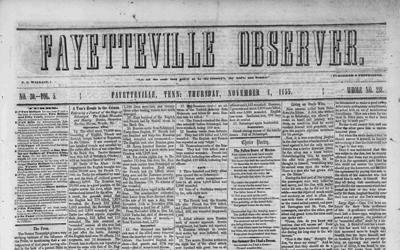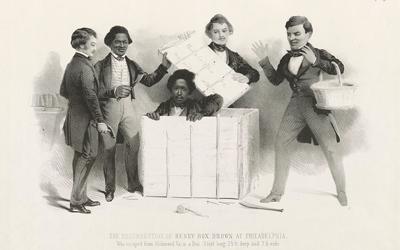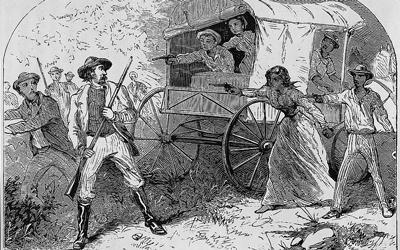How "underground" was the Underground Railroad?
People who had escaped their enslavement headed north to gain their freedom and to escape intolerable situations. They needed courage and resourcefulness to evade law enforcement officers and professional slave catchers who earned rewards for returning them to their masters. Southerners bitterly resented those in the North who assisted the slaves. They coined the term “Underground Railroad” to mean an organized network devoted to keep slaves away from their masters, sometimes even crossing the border into Canada. There was no actual physical “railroad” with engines and tracks, but the term stuck. In 1850, Congress passed the Fugitive Slave Law that levied heavy fines on anyone guilty of helping slaves to escape. Many in the north resented the law that forced them to help sustain a system that they opposed.
Underground Railroad "Stations" Develop in Iowa
Iowa shares a southern border with Missouri, which was a slave state. In the 1840s and 1850s, abolitionists (those who wanted to abolish slavery) developed a system of “stations” that could move runaways toward the Mississippi River to Illinois on their way to freedom. Members of two religious groups, the Congregationalists and Quakers, played leading roles in abolitionist activities. They were also active in the Underground Railroad in the state.
Because it had to be secret, we have few written records about the Underground Railroad in Iowa. One source has identified more than 100 Iowans involved in the effort. A main route across the state started in southwest Iowa near Council Bluffs where a free black, John Williamson, helped those fleeing slavery on their road to freedom. Hitchcock House in Cass County near Lewis is another known stop in one way or another with the Underground Railroad. Rev. George Hitchcock, a Congregationalist minister, passed along "passengers" to the next stop. James Jordan in West Des Moines and Josiah Grinnell in Grinnell were also leaders of the effort. Several of these sites are now museums open to the public.
It is impossible to know the numbers of blacks the Underground Railroad assisted. Individual families also responded when asked for help. Free blacks living in the state, particularly in southeast Iowa, were often involved. When the Civil War started and the Fugitive Slave Law could no longer be enforced in the north, many blacks escaped into the state and became permanent residents. In 1868, Iowa granted black men the right to vote. The Supreme Court ruled that segregated schools and discrimination in public accommodations were illegal in Iowa.
Iowa: A Free State Willing to Let Slavery Exist
Slavery was a divisive issue for the United States from its very creation. The early conflicts were not about slavery in the South but its extension as new states joined the Union. The Missouri Compromise of 1820 established an east-west line along the southern border of Missouri that would forever divide free/slave settlement. States to the south could allow slavery; states to the north (with the exception of slave state Missouri) could not.
Settlers knew that Iowa would be a free state. Most Iowans were willing to let slavery exist in the South. Like most white Americans of the time period, they believed in the superiority of the white race and opposed granting equal rights or opportunities to African Americans. They passed laws attempting to discourage blacks from coming to the state. On the national level, they wanted most of all to find compromises that would keep the Union together. Iowa did have a small population of abolitionists who wanted to abolish slavery everywhere as a moral evil.
In 1854, Congress passed the Kansas-Nebraska Act that allowed the settlers in any new territory to decide the slavery issue there for themselves. This opened the possibility that Nebraska on Iowa’s western border could become a slave state. Most Iowans opposed that prospect. The Republican Party emerged strongly opposed to any further extension of slavery into western territories.
Supporting Questions
How dangerous was the Underground Railroad?
- $200 Reward: Poster for the Return of Formerly-Enslaved People, October 1, 1847 (Document)
- "Effects of the Fugitive-Slave-Law" Print, 1850 (Image)
- Fugitive Slave Law, 1850 (Document)
How did runaway slaves rely on the help of abolitionists to escape to freedom?
- Anti-Slavery Bugle Article - "William and Ellen Craft," February 23, 1849 (Document)
- Anti-Slavery Bugle Article - "Underground Railroad," September 16, 1854 (Document)
- "A Presbyterian Clergyman Suspended for Being Connected with the Underground Railroad" Article, November 8, 1855 (Document)
- William Maxson Home in West Liberty, Iowa, 1890 (Image)
- "Fugitive Slave Case Was Tried" The Daily Gate City Article, April 13, 1915 (Document)
How did some runaway slaves create their own opportunities to escape?
- "The 'Running of Slaves' - The Extraordinary Escape of Henry Box Brown" Article, June 23, 1849 (Document)
- Henry "Box" Brown Song and the Engraved Box, 1850 (Image, Document)
- "The Resurrection of Henry 'Box' Brown at Philadelphia" Illustration, 1850 (Image)
- Robert Smalls: "The Steamer 'Planter' and Her Captor," June 14, 1862 (Document)
- "A Bold Stroke for Freedom" Illustration, 1872 (Image)
| Underground Railroad Source Set Teaching Guide |
| Printable Image and Document Guide |
$200 Reward: Poster for the Return of Formerly-Enslaved People, October 1, 1847

Description
After a person escaped enslavement, many relied on northern whites to lead them safely to the northern free states and to Canada. It was very dangerous to be a formerly-enslaved person. There were rewards for their capture, and advertisements like the reward poster here…
"Effects of the Fugitive-Slave-Law" Illustration, 1850

Description
An impassioned condemnation of the Fugitive Slave Act passed by Congress in September 1850, which increased federal and free-state responsibility for the recovery of fugitive slaves. The law provided for the appointment of federal commissioners empowered to…
Fugitive Slave Law, 1850

Description
The Fugitive Slave Law of 1850 made it illegal for anyone in the north to assist fugitive slaves in their escape for freedom. This law added further provisions to the 1793 Fugitive Slave Act regarding runaways and levied even harsher punishments for…
Anti-Slavery Bugle Article - "William and Ellen Craft," February 23, 1849

Description
The article from the abolitionist newspaper, The Anti-Slavery Bugle, recounts the story of Ellen and William Craft’s escape from slavery. Ellen wore the clothes of a man to past as the master, while her husband, William, pretended to be her servant as they escaped…
Anti-Slavery Bugle Article - "Underground Railroad," September 16, 1854

Description
The Anti-Slavery Bugle article reports the number of escaped slaves in northern cities in 1854. This included nine slaves from Boone County, Kentucky, who were seeking asylum. Their masters were described to be looking for them in Cincinnati, and were…
"A Presbyterian Clergyman Suspended for Being Connected with the Underground Railroad" Article, November 8, 1855

Description
This newspaper article was published in Fayettville, Tennessee, in 1855. The article describes how one clergyman in Indiana, Rev. T. B. McCormick, was suspended for being a member of the Underground Railroad. He is accused in the story of assisting fugitive slaves in their…
William Maxson Home in West Liberty, Iowa, 1890

Description
The William Maxson home, located in Springdale, Iowa, was an Underground Railroad station in the mid 1800's. The home was where abolitionist John Brown trained with his men for the raid on Harpers Ferry. The house has since been torn down, but was near Springdale,…
"Fugitive Slave Case Was Tried" - A Daily Gate City Article, April 13, 1915

Description
This article was published in The Daily Gate City newspaper of Keokuk, Iowa, in 1915, about trial held in Burlington in 1850. The sum of $10,000 in damages was asked by plaintiff, Buel Daggs, as compensation for the services of nine slaves who escaped from…
"The 'Running of Slaves' - The Extraordinary Escape of Henry 'Box' Brown" Article, June 23, 1849

Download Resource Download Resource
Description
The article from The Sunbury American newspaper in Northumberland County (Pennsylvania) focused on the escape by Henry "Box" Brown in 1849. Brown shipped himself in a wooden crate from Richmond, Virginia, to Philadelphia, Pennsylvania, to a group of…
Henry "Box" Brown Song and the Engraved Box, 1850

Description
The image shows the engraving on the box that Henry "Box" Brown made and shipped himself in to freedom in Virginia. The box is marked “Right side up with care.” The attached song was sung by Henry "Box" Brown when he emerged from the box in Philadelphia, Pennsylvania, in…
"The Resurrection of Henry 'Box' Brown at Philadelphia" Illustration, 1850

Description
The illustration shows a somewhat comic yet sympathetic portrayal of the culminating episode in the flight of slave Henry "Box" Brown, "who escaped from Richmond Va. in a Box 3 feet long, 2-1/2 ft. deep and 2 ft. wide." In the office of the Pennsylvania Anti-Slavery Society…
Robert Smalls: "The Steamer 'Planter' and Her Captor," June 14, 1862

Description
The article from Harper's Weekly described the escape of Robert Smalls and several members of his family and friends from slavery. Smalls was an enslaved African American who, during and after the American Civil War, gained freedom and became a ship's pilot,…
"A Bold Stroke for Freedom" Illustration, 1872

Description
The 1872 illustration shows African Americans, likely fugitive slaves, with a wagon pointing guns at slave-catchers. The cartoon is thought to depict Christmas Eve of 1855, when patrollers caught up with a group of teenage enslaved people who had escaped by wagon…
Additional Resources:
- Harriet Tubman
- Harriet Ross Tubman Day
The website includes the statement made by the State of Delaware about the observance of Harriet Ross Tubman Day on March 10, 2017. The statement was signed by Gov. John Carney and Lt. Gov. Bethany Hall-Long. - Harriet Tubman - Online Resource Guide
These digital collections from the Library of Congress contain a wide variety of material associated with Harriet Tubman, including manuscripts, photographs and books. This guide compiles links to digital materials related to Harriet Tubman that are available throughout the Library of Congress website. - Scenes in the Life of Harriet Tubman
Available through the Digital Public Library of America, the website provides excerpts from the novel, Scenes in the Life of Harriet Tubman, by Sarah Bradford in 1869.
- Harriet Ross Tubman Day
- Pathways to Freedom - Maryland and the Underground Railroad
This website offers primary documents relating to Maryland and the Underground Railroad. This includes information from three former slaves, Samuel Green and Phoebe Myers. - "The Secret History of the Underground Railroad" by Eric Foner
This article from The Atlantic focuses on the "secret history" of the Underground Railroad, including the fact that the network was not nearly as hidden as many presumed. - William and Ellen Craft Escape from Slavery
In this webpage from "Documenting the American South," the focus is on how slaves William and Ellen Craft escaped from Georgia to seek asylum and freedom in the North.
Iowa Core Social Studies Standards (8th Grade)
Listed below are the Iowa Core Social Studies content anchor standards that are best reflected in this source set. The content standards applied to this set are middle school-age level and encompass the key disciplines that make up social studies for eighth grade students.
| No. | Standard Decsription |
| SS.8.13. | Explain the powers and responsibilities of citizens, political parties, and the media in a variety of governmental and nongovernmental contexts. (21st century skills) |
| SS.8.19 | Explain how push and pull factors contributed to immigration and migration in early American history. |
| SS.8.21. | Analyze connections among early American historical events and developments in broader historical contexts. |
| SS.8.22. | Explain how how and why prevailing social, cultural, and political perspectives changed during early American history. |
| SS.8.23. | Explain multiple causes and effects and developments in early American history. |
| SS.8.24. | Critique primary and secondary sources of information with attention to the source of the document, its context, accuracy, and usefulness such as the Declaration of Independence, the Bill of Rights, the Constitution, Washington's Farewell address, the Louisiana Purchase treaty, Monroe Doctrine, Indian Removal Act, Missouri Compromise, Dred Scott v. Sanford, and the Treaty of Guadalupe-Hidalgo. |